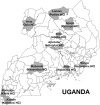Plasmodium Species Infecting Children Presenting with Malaria in Uganda
- PMID: 28990911
- PMCID: PMC5590612
- DOI: 10.4269/ajtmh.17-0345
Plasmodium Species Infecting Children Presenting with Malaria in Uganda
Abstract
Contributions of species other than Plasmodium falciparum to human malaria in sub-Saharan Africa are uncertain. We collected blood from children aged 6 months to 10 years diagnosed with malaria by Giemsa-stained blood smears (176 subjects) or histidine rich protein-2-based rapid diagnostic tests (323 subjects) in 2016; 50 samples from each of 10 sites across Uganda were studied to identify infecting species. Of 499 available samples, 474 demonstrated plasmodial infection by polymerase chain reaction amplification of 18S ribosomal RNA genes, including P. falciparum in 472, Plasmodium malariae in 22, Plasmodium ovale in 15, and Plasmodium vivax in four; 435 were pure P. falciparum, two did not contain P. falciparum, and the remainder were mixed infections including P. falciparum. The prevalence of nonfalciparum species varied geographically. Stratifying based on recent history of indoor residual spraying (IRS) of insecticides, nonfalciparum infections were seen in 27/189 (14.8%) samples from sites that received and 13/285 (4.6%) samples from sites that did not receive IRS since 2010 (P = 0.0013). Overall, 39/474 (8.2%) samples from individuals diagnosed with malaria included nonfalciparum infections. Thus, a substantial proportion of episodes of malaria in Uganda include infections with plasmodial species other than P. falciparum.
Figures
References
-
- White NJ, Pukrittayakamee S, Hien TT, Faiz MA, Mokuolu OA, Dondorp AM, 2014. Malaria. Lancet 383: 723–735. - PubMed
-
- Mouatcho JC, Goldring JP, 2013. Malaria rapid diagnostic tests: challenges and prospects. J Med Microbiol 62: 1491–1505. - PubMed
-
- World Health Organization, 2015. Guidelines for the Treatment of Malaria. Geneva, Switzerland: WHO.
MeSH terms
Grants and funding
LinkOut - more resources
Full Text Sources
Other Literature Sources
Medical


